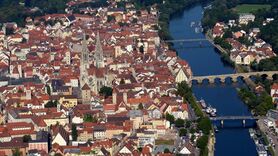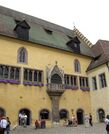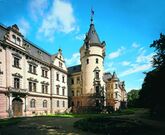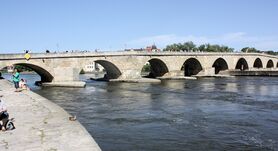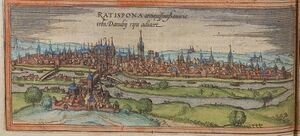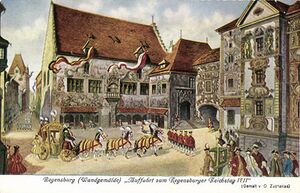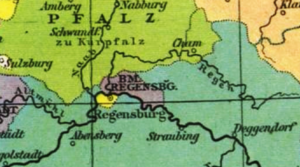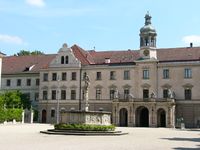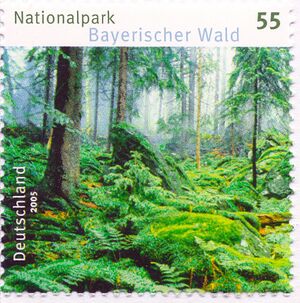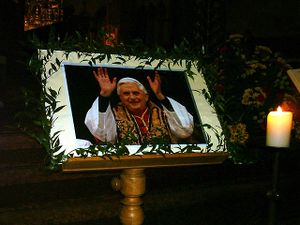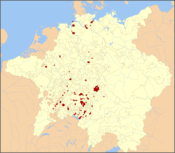رگنزبورگ
رگنزبورگ Regensburg | |
|---|---|
| الإحداثيات: 49°1′N 12°5′E / 49.017°N 12.083°E | |
| البلد | ألمانيا |
| الولاية | باڤاريا |
| District | Urban district |
| التقسيمات | 18 districts |
| الحكومة | |
| • Lord mayor | Gertrud Maltz-Schwarzfischer (SPD) |
| المساحة | |
| • الإجمالي | 80٫76 كم² (31٫18 ميل²) |
| التعداد (2006-9-30) | |
| • الإجمالي | 130٬080 |
| • الكثافة | 1٬600/km2 (4٬200/sq mi) |
| منطقة التوقيت | CET/CEST (UTC+1/+2) |
| Postal codes | 93001–93059 |
| Dialling codes | 0941 |
| لوحة السيارة | R |
| الموقع الإلكتروني | www.regensburg.de |
| موقع تراث عالمي لليونسكو | |
| Official name | Old town of Regensburg with Stadtamhof |
| السمات | Cultural: ii, iii, iv |
| مراجع | 1155 |
| التدوين | 2006 (30 Session) |
| المساحة | 182.8 ha |
| منطقة عازلة | 775.6 ha |
رگنزبورگ ( Regensburg ؛ US: /ˈreɪɡənzbɜːrɡ, ˈreɪɡənsbʊərk/,[1][2] ألمانية: [ˈʁeːɡn̩sbʊɐ̯k] (![]() listen); older إنگليزية: Ratisbon /ˈrætɪsbɒn/;[3] باڤارية: Rengschburg أو Rengschburch) هي مدينة في جنوب شرق ألمانيا، عند ملتقى أنهار الدانوب وناب و رگن. وبتعداد يربو على 150,000 نسمة، فإن رگنزبورگ هي رابع أكبر مدينة في ولاية باڤاريا بعد ميونخ و نورمبرگ و أوگسبورگ. المدينة هي المركز السياسي والاقتصادي والثقافي وعاصمة Upper Palatinate.
listen); older إنگليزية: Ratisbon /ˈrætɪsbɒn/;[3] باڤارية: Rengschburg أو Rengschburch) هي مدينة في جنوب شرق ألمانيا، عند ملتقى أنهار الدانوب وناب و رگن. وبتعداد يربو على 150,000 نسمة، فإن رگنزبورگ هي رابع أكبر مدينة في ولاية باڤاريا بعد ميونخ و نورمبرگ و أوگسبورگ. المدينة هي المركز السياسي والاقتصادي والثقافي وعاصمة Upper Palatinate.
The medieval centre of the city is a UNESCO World Heritage Site. In 2014, Regensburg was among the top sights and travel attractions in Germany.[4]
التاريخ
التاريخ المبكر
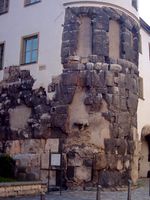
The first settlements in the Regensburg area date from the Stone Age. The oldest Celtic name given to a settlement near Regensburg was Radasbona, a site where a Roman fort was built around AD 90. In 179, a major new Roman fort, called Castra Regina ("fortress by the river Regen"), was built for Legio III Italica during the reign of Emperor Marcus Aurelius.[5] It was an important camp at the most northerly point of the Danube; it corresponds to what is today the core of Regensburg's Old City or Altstadt east of the Obere and Untere Bachgasse and west of the Schwanenplatz. It is believed that as early as the late Roman period the city was the seat of a bishop.
From the early 6th century, Regensburg was the seat of a ruling family known as the Agilolfings. From about 530 to the first half of the 13th century, it was the capital of Bavaria. The bisphoric established by the Romans was re-established by St Boniface as the Bishopric of Regensburg in 739. In the late 8th century, Regensburg remained an important city during the reign of Charlemagne. In 792, Regensburg hosted the ecclesiastical section of Charlemagne's General Assembly, the bishops in council who condemned the heresy of the nontrinitarian adoptionism doctrine taught by their Spanish counterparts, Elipandus of Toledo and Felix of Urgell. After the partition of the Carolingian Empire in 843, the city became the seat of the Eastern Frankish ruler, Louis the German. Two years later, 14 Bohemian princes came to Regensburg to receive baptism there. This was the starting point of the Christianization of the Czechs, and the diocese of Regensburg became the mother diocese of that of Prague. These events had a wide impact on the cultural history of the Czech lands, as they were consequently part of the Roman Catholic and not the Slavic-Orthodox world. On 8 December 899 Arnulf of Carinthia, a descendant of Charlemagne, died at Regensburg.[6]
By the High Middle Ages in the year 1000, the population increased to 40,000 from 23,000 inhabitants in 800.[7] In 1096, on the way to the First Crusade, Peter the Hermit led a mob of crusaders who attempted to force the mass conversion of Jews in Regensburg, they then killed all those who resisted.[8] Between 1135 and 1146, the Stone Bridge across the Danube was built at Regensburg. This bridge opened major international trade routes between northern Europe and Venice, and this began Regensburg's golden age as a residence of wealthy trading families. Regensburg became the cultural centre of southern Germany and was celebrated for its gold work and fabrics.
Late Middle Ages and early modern period
مدينة رگنزبورگ الامبراطورية Reichsstadt Regensburg (ألمانية) | |||||||||
|---|---|---|---|---|---|---|---|---|---|
| 1245–1803 | |||||||||
| الوضع | City-state of الامبراطورية الرومانية المقدسة | ||||||||
| العاصمة | رگنزبورگ | ||||||||
| الحكومة | جمهورية | ||||||||
| الحقبة التاريخية | Middle Ages | ||||||||
• Gained Imperial immediacy (Reichsfreiheit)a | 1245 | ||||||||
• City annexed by باڤاريا | 1486–96 | ||||||||
| 1541 | |||||||||
• City adopted Reformation | 1542 | ||||||||
| 1663 | |||||||||
• Mediatised إلى مطرانية جديدة2 | 27 April 1803 | ||||||||
• انتقلت إلى باڤاريا طبقاً لمعاهدة پاريس | 1810 | ||||||||
| |||||||||
| اليوم جزء من | ألمانيا | ||||||||
a: أسقفية رگنزبورگ acquired Imperial immediacy around the same time as the City. Of the three Imperial Abbeys in Regensburg, Niedermünster had already acquired immediacy in 1002, St. Emmeram's Abbey did in 1295 and Obermünster in 1315. b: The Bishopric, the Imperial City and all three Imperial Abbeys were mediatised simultaneously. | |||||||||
In 1245 Regensburg became a Free Imperial City and was a trade centre before the shifting of trade routes in the late Middle Ages. Regensburg has always been a place where international meetings were held. This was also the case in 1471 when a war against the Turks was to be decided.[9] In 1486, Regensburg became part of the Duchy of Bavaria, but its independence was restored by the Holy Roman Emperor ten years later. The first Diet of Regensburg took place in 1541. The city adopted the Protestant Reformation in 1542 and its Town Council remained entirely Lutheran.
From 1663 to 1806, the city was the permanent seat of the Imperial Diet of the Holy Roman Empire, which became known as the Perpetual Diet of Regensburg. Thus, Regensburg was one of the central towns of the Empire, attracting visitors in large numbers.
A minority of the population remained Roman Catholic, and Roman Catholics were denied civic rights (Bürgerrecht). Although the Imperial city had adopted the Reformation, the town remained the seat of a Roman Catholic bishop and several abbeys. Three of these, St. Emmeram, Niedermünster and Obermünster, were free imperial estates within the Holy Roman Empire, meaning that they were granted a seat and a vote at the Imperial Diet (Reichstag). So there was the unique situation that the town of Regensburg comprised five independent "states" (in terms of the Holy Roman Empire): the Protestant city itself, the Roman Catholic bishopric, and the three monasteries. In addition, it was seen as the traditional capital of the region Bavaria (not the state), acted as functional co-capital of the Empire (second to the Emperor's court at Vienna) due to the presence of the Perpetual Diet, and it was the residence of the Emperor's Commissary-Principal to the same diet, who with one very brief exception was a prince himself (for many years the Prince of Thurn and Taxis, still resident in the town).
Late modern period
In 1803 the city lost its status as an imperial city following its incorporation into the Principality of Regensburg. It was handed over to the Archbishop-Elector of Mainz and Archchancellor of the Holy Roman Empire Carl von Dalberg in compensation for the territory of the Electorate of Mainz located on the left bank of the Rhine which had been annexed by France under the terms of the Treaty of Lunéville in 1801. The Archbishopric of Mainz was formally transferred to Regensburg. Dalberg united the bishopric, the monasteries, and the town itself, making up the Principality of Regensburg (Fürstentum Regensburg). Dalberg strictly modernized public life. Most importantly, he awarded equal rights to Protestants and Roman Catholics alike. In 1810 Dalberg ceded Regensburg to the Kingdom of Bavaria, he himself being compensated by the award of Fulda and Hanau to him under the title of "Grand Duke of Frankfurt".
Between April 19 and April 23, 1809, Regensburg was the scene of the Battle of Ratisbon between forces commanded by Henri Gatien Bertrand and Napoleon himself and the retreating Austrian forces. The city was eventually overrun, after supplies and ammunition ran out. The city suffered severe damage during the fight, with about 150 houses being burnt and others being looted. Robert Browning's poem Incident at the French Camp describes the battle from the French perspective, but is filled with historical errors.
Nazism and World War II
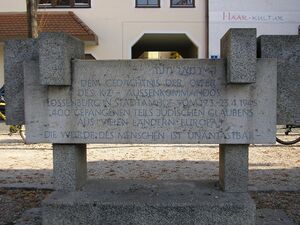
The Jewish community was persecuted after the Nazi Party came to power in Germany in 1933, many Jews fled in the following years, and some were also expelled to Poland; thanks, however, to a Polish-German agreement they were allowed to return to the city.[10] On November 9, 1938, during the Kristallnacht, the Regensburg Synagogue and several Jewish homes and stores were destroyed, and around 220 Jews were arrested, some were also deported to the Dachau concentration camp.[10] During World War II, many Jews emigrated to various countries, and in 1942, over 200 Jews were deported either to Piaski in German-occupied Poland or the Theresienstadt Ghetto in German-occupied Czechoslovakia.[11] In the final months of World War II, in March and April 1945, the Regensburg subcamp of the Flossenbürg concentration camp was located in the city, with 460 forced laborers of various nationalities, 40 of whom died.[12]
Regensburg was home to both a Messerschmitt Bf 109 aircraft factory and an oil refinery, which were bombed by the Allies on August 17, 1943, in the Schweinfurt-Regensburg mission, and on February 5, 1945, during the Oil Campaign of World War II. Although both targets were badly damaged, Regensburg itself suffered little damage from the Allied strategic bombing campaign, and the nearly intact medieval city centre is listed as a UNESCO World Heritage Site. The city's most important cultural loss was that of the Romanesque church of Obermünster, which was destroyed in a March 1945 air raid and was not rebuilt (the belfry survived). Also, Regensburg's slow economic recovery after the war ensured that historic buildings were not torn down and replaced by newer ones. When the upswing in restoration[مطلوب توضيح] reached Regensburg in the late 1960s, the prevailing mindset had turned in favour of preserving the city's heritage.
History after 1945
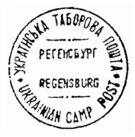
Between 1945 and 1949, Regensburg was the site of the largest displaced persons (DP) camp in Germany. At its peak in 1946–1947, the workers' district of Ganghofersiedlung housed almost 5,000 Ukrainian and 1,000 non-Ukrainian refugees and displaced persons. With the approval of U.S. Military Government in the American Allied Occupation Zone, Regensburg and other DP camps organised their own camp postal service. In Regensburg, the camp postal service began operation on December 11, 1946.[13]
At the beginning of the 1960s, Regensburg invested heavily in technical and social infrastructure to attract industry. Siemens was the first multinational company to come to Regensburg, a significant step in the city's development after World War II. In 1965, Regensburg University was founded; Regensburg University of Applied Sciences was established in 1971. The second multinational company, BMW, arrived in 1986 and set up a large production plant. Since the 1990s, several well-known hightech companies have been located in Regensburg, such as Infineon and OSRAM, contributing to the city's current wealth.
In 1997, Regensburg was awarded the Europe Prize for its outstanding achievements in European integration.[14]
The World Heritage Committee listed Regensburg's Old Town a UNESCO World Heritage Site in July 2006. It is one of the largest medieval old towns north of the Alps and very well preserved, with the nickname "Italy's most northern city".[15] Close to the Stone Bridge, the city of Regensburg established a World Heritage Centre in the historic Salzstadl in 2007, where detailed information on Regensburg's 2000-year history is given.
الجغرافيا
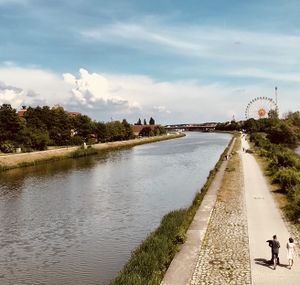
الطبوغرافيا
Regensburg is situated on the northernmost part of the Danube river at the geological crossroads of four distinct landscapes:
- to the north and northeast lies the Bavarian Forest with granite and gneiss mountains, wide forests and its national park
- to the east and south-east is the fertile Danube plain (Gäuboden) which are highly cultivated loess plains
- the south is dominated by the Tertiary Hill Country, a continuation of Alpine Foreland
- to the West is Franconian Jura
المناخ
Regensburg straddles the humid continental (Dfb) and oceanic (Cfb) climate zones under the Köppen climate classification. While the average temperature of 8.5 °C (47.3 °F) in the period from 1971 to 2000 is slightly above the German average (7.8 °C أو 46.0 °F), still only 5 of the 80 cities in Germany above 100,000 inhabitants are colder. The average precipitation of 636 ميليمتر (25.0 بوصات) per year ranges slightly below the German average (approximately 700 ميليمتر أو 28 بوصات). For the newer period from 1981 to 2010 the average temperature and precipitation rose up to 8.9 °C (48.0 °F) respectively 658 ميليمتر (25.9 بوصات). As this increase in the average temperature can also be seen in the other cities, Regensburg still ranks fifth place (shared with Ingolstadt and Kiel) in the above-mentioned ranking.[16] With a total of 1670 sunshine hours per year, Regensburg is roughly 120 hours above German average.[17]
The warmest month of the year, on average, is July. The coolest month of the year, on average, is January.
| بيانات المناخ لـ رگنزبورگ | |||||||||||||
|---|---|---|---|---|---|---|---|---|---|---|---|---|---|
| الشهر | ينا | فب | مار | أبر | ماي | يون | يول | أغس | سبت | أكت | نوف | ديس | السنة |
| متوسط القصوى اليومية °س (°ف) | 2.6 (36.7) |
4.1 (39.4) |
10.5 (50.9) |
17.3 (63.1) |
20.6 (69.1) |
24.2 (75.6) |
26.3 (79.3) |
24.5 (76.1) |
20.6 (69.1) |
14.4 (57.9) |
7.2 (45.0) |
2.9 (37.2) |
14.6 (58.3) |
| متوسط الدنيا اليومية °س (°ف) | −2.6 (27.3) |
−2.8 (27.0) |
0.1 (32.2) |
4.4 (39.9) |
8.1 (46.6) |
11.8 (53.2) |
13.6 (56.5) |
12.5 (54.5) |
9.3 (48.7) |
5.1 (41.2) |
1.8 (35.2) |
−1.7 (28.9) |
5.0 (41.0) |
| متوسط تساقط الأمطار mm (inches) | 51 (2.0) |
34 (1.3) |
37 (1.5) |
41 (1.6) |
76 (3.0) |
77 (3.0) |
81 (3.2) |
79 (3.1) |
43 (1.7) |
38 (1.5) |
45 (1.8) |
56 (2.2) |
658 (25.9) |
| متوسط الرطوبة النسبية (%) | 88 | 84 | 78 | 72 | 71 | 71 | 70 | 74 | 79 | 84 | 88 | 89 | 79 |
| Mean monthly ساعات سطوع الشمس | 44 | 73 | 140 | 194 | 211 | 226 | 240 | 194 | 158 | 105 | 45 | 37 | 1٬667 |
| Source 1: World Meteorological Organisation[18] | |||||||||||||
| Source 2: German Weather Service[19] | |||||||||||||
المعالم الرئيسية
المدينة
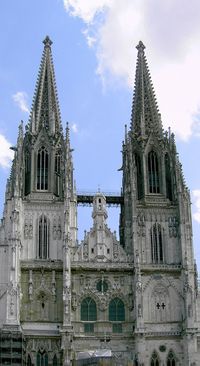
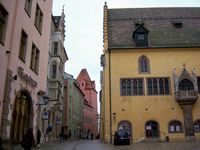
Regensburg includes the largest medieval old town north of the Alps with nearly 1,500 listed buildings and a picturesque cityscape. Its most famous sights are located mainly in the Old Town, such as:
- The Dom (Cathedral) is an example of pure German Gothic and is regarded as the main work of Gothic architecture in Bavaria. It was founded in 1275 and completed in 1634, with the exception of the towers, which were finished in 1869. The interior contains numerous interesting monuments, including one of Peter Vischer's masterpieces. Adjoining the cloisters are two chapels which predate the cathedral. One of these, known as the old cathedral, goes back perhaps to the 8th century.[20] The official choir for the liturgical music at St Peter's Cathedral is the famous Regensburger Domspatzen ("cathedral sparrows").
- The stone bridge, built 1135–1146, is a highlight of medieval bridge building. The knights of the 2nd and 3rd crusades used it to cross the Danube on their way to the Holy Land.
- The Regensburg Sausage Kitchen is a major tourist destination, but locals eat there as well. It was originally built as the construction headquarters of the stone bridge and now lies adjacent to it.
- Remains of the Roman fortress' walls including the Porta Praetoria.
- The Church of St. James, also called Schottenkirche, a Romanesque basilica of the 12th century, derives its name from the monastery of Irish Benedictines (Scoti) to which it was attached; the principal doorway is covered with very unusual grotesque carvings.[20] It stands next to the Jakobstor, a medieval city gate named after it.
- The old parish church of St. Ulrich is a good example of the Transition style of the 13th century, and contains a valuable antiquarian collection.[20] It houses the diocesan museum of religious art.
- Examples of the Romanesque basilica style are the church of Obermünster, dating from 1010, and the abbey church of St. Emmeram, built in the 13th century, remarkable as one of the few German churches with a detached bell tower. The cloisters of the ancient abbey, one of the oldest in Germany, are still in a fair state of preservation. In 1809 the conventual buildings were converted into a palace for the prince of Thurn and Taxis, hereditary postmaster-general of the Holy Roman Empire.[20]
- The Adler-Apotheke, located nearby the Regensburg Cathedral, was founded in 1610 and is one of the oldest pharmacies in Regensburg. The ancient interior and historical vessels can be viewed.
- Wealthy patrician families competed against each other to see who could build the highest tower of the city. In 1260, the Goldener Turm (golden tower) was built on Wahlenstraße.
- The Old Town Hall, dating in part from the 14th century, contains the rooms occupied by the Imperial Diet from 1663 to 1806.[20]
- The Gasthof zum Goldenen Kreuz (Golden Cross Inn) is also of historical interest: it is where Charles V made the acquaintance of Barbara Blomberg, the mother of Don John of Austria.[20]
- The statue of John of Austria, born 1547 in Regensburg, was erected 1978 on the fourth centenary of his death and is a copy of a monument in Messina, Italy.
- Perhaps the most pleasant modern building in the city is the Gothic villa of the king of Bavaria on the bank of the Danube.[20] The grounds are now opened to public and known as VillaPark.
- Among the public institutions of the city are the public library, picture gallery, botanical garden, and the institute for the making of stained glass. The city's colleges (apart from the University of Regensburg) include an episcopal clerical seminary, and a school of church music.[20]
- St. Emmeram's Abbey, now known as Schloss Thurn und Taxis, is a huge castle owned by the powerful Thurn and Taxis family.
- Schloss Höfling, a castle owned by the Thurn und Taxis family
- The City Park, the oldest and largest park in Regensburg with a lot of artwork.
- The Botanischer Garten der Universität Regensburg is a modern botanical garden located on the University of Regensburg campus.
- Herzogspark also contains several small botanical gardens.

الجوار
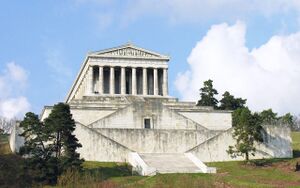
Near Regensburg there are two very imposing classical buildings erected by Ludwig I of Bavaria as national monuments dedicated to German patriotism and greatness:[20]
- The more imposing of the two is the Walhalla, a costly reproduction of the Parthenon, erected as a Teutonic temple of fame on a hill rising from the Danube at Donaustauf, 10 كيلومتر (6.2 ميل) to the east. The interior, which is richly decorated with coloured marble, gilding and sculptures, contains the busts of more than one hundred notable Germans.[20]
- The second of King Ludwig's buildings is the Befreiungshalle at Kelheim, 25 كيلومتر (16 ميل) higher up the Danube. It is a large circular monument built for the glorification of the heroes of the 1813 War of Liberation.[20]
Weltenburg Abbey (Kloster Weltenburg), a Benedictine monastery, is located in Weltenburg near the town of Kelheim. The abbey is situated on a peninsula of the Danube, by what are known as the "Weltenburg Narrows" or "Danube Gorge". The monastery, founded by Irish or Scottish monks in about 620, is said to be the oldest monastery in Bavaria.
To the east of Regensburg lies the Bavarian Forest and its National Park, one of the most visited protected areas in Germany.
Regensburg is on the designated heritage route, the Route of Emperors and Kings.[21]
السكان
Population
In May 2017, Regensburg had 164,896 inhabitants,[22] making it the fourth largest city in Bavaria. Over the last hundred years, the city has experienced a strong increase in population, surpassing 100,000 inhabitants in 1945 due to Germans who were ethnically cleansed from eastern parts of the Third Reich, especially from the Sudetenland. Today, Regensburg is one of the fastest-growing cities in Germany.
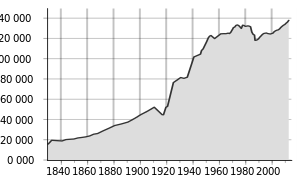
International communities
Nearly 12% of the total population are foreign residents. Most of them come from Turkey and Central and Eastern Europe:[23]
| Nation | Population (31.12 2019) |
|---|---|
| 2,660 | |
| 1,970 | |
| 1,605 | |
| 1,535 | |
| 1,480 | |
| Total: | 30,535 |
الدين
A majority of Regensburg's population is Roman Catholic. In 2017, about 51.4% of the city's inhabitants identified with the Roman Catholic Church, 13.1% were registered Protestants and about 35.5% identified with other religions or did not have any registered religious affiliation.[24]
السياسة
الحكومة
The Lord Mayor and the City Council are elected for a period of six years. Both elections take place at the same time. The City Council is composed of 51 members and includes the Lord Mayor, two deputy mayors, five counsellors and the other council members.
The municipal elections in Bavaria of 2014 delivered the following results:
| Party | votes | change | seats | change | cooperation |
|---|---|---|---|---|---|
| Social Democratic Party | 33,7% | +12,2 | 17 | +6 | X |
| Christian Social Union | 32,8% | –7,1 | 16 | –4 | |
| The Greens | 10,5% | -0,1 | 5 | - | X |
| Free Voters | 6,9% | -0,2 | 3 | -1 | X |
| Ecological Democratic Party | 6,4% | -0,5 | 3 | - | |
| The Left | 3,1% | -1,5 | 2 | - | |
| Free Democratic Party | 3,0% | -2,4 | 2 | -1 | X |
| Pirate Party | 2,3% | +2,3 | 1 | +1 | X |
| Christian Social Federation | 1,5% | -2,3 | 1 | -1 |
After 18 years of a City Council with conservative majority, the social-democratic candidate, Joachim Wolbergs, became Lord Mayor of Regensburg in May 2014. He was succeeded by Gertrud Maltz-Schwarzfischer in May 2020, who is also a social-democratic politician.
البلدات التوأم - المدن الشقيقة
Regensburg is twinned with:
|
|
الاقتصاد
Regensburg's economy counts among the most dynamic and fastest growing in Germany.[27] Focus is on manufacturing industries, such as automotive, industrial and electrical engineering.
أبرز السكان
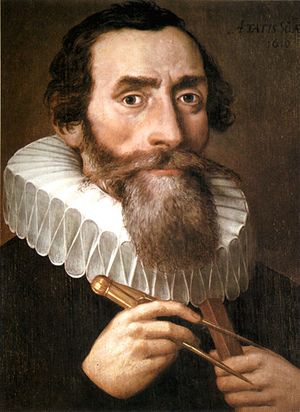
- Pope Benedict XVI, professor of theology at the University of Regensburg from 1969 to 1977, who retains the title honorary professor; he is not a former resident of the city of Regensburg, but his house, less than 1 kilometer from the city, lies in Pentling in the district of Regensburg. He has been an honorary citizen since 2006.
- The Princely House of Thurn und Taxis, a German noble family and one of Europe's largest landowners
- John of Austria, born 1547 in Regensburg
- Joseph Hanisch, musician, composer and organist.[28]
- Albrecht Altdorfer (printmaker, painter of landscapes, historical and Biblical subjects of the Renaissance)
- Willie Duncan (Spider Murphy Gang)
- Ulrich Eberl, science and technology journalist
- The Rev. Dr. Franz Xaver Haberl, one of the most important Roman Catholic musicians in history, teacher of Perosi (see also Cecilian Movement)
- Johann Georg Gichtel (1638-1710) was a German mystic and religious leader who was a critic of Lutheranism[29]
- Johannes Kepler (mathematician and astronomer)
- Konrad of Megenberg, scholar and academic[30]
- Simone Laudehr (German national team footballer, women's world cup champion 2007)
- Albertus Magnus (13th century polymath)
- Judah ben Samuel of Regensburg, a 12th–13th century rabbi and mystic, founder of Chassidei Ashkenaz
- Maximilian Oberst, physician who introduced the Oberst method of block anesthesia
- Petachiah of Ratisbon, a 12th–13th century rabbi, best known for his extensive travels throughout Eastern Europe, the Caucasus, and the Middle East.
- Elise Barensfeld (1796–after 1820) soprano
- Hisham Zreiq (born 1968), award-winning Palestinian Christian Independent filmmaker, poet and visual artist.
- Walter Röhrl (racing driver)
- Saint Emmeram, Christian bishop and a martyr, St. Emmeram's Abbey
- Andrea Maria Schenkel, best-selling author of Tannöd and other works.
- Emanuel Schikaneder (Librettist of The Magic Flute)
- Oskar Schindler (1908–1974), German industrialist (after World War II until his emigration to Argentina)
- Ulrich Schmidl (supposed co-founder of Buenos Aires)[بحاجة لمصدر]
- Anton Vilsmeier, (1894–1962), German chemist best known for the Vilsmeier-Haack reaction, born in Burgweinting, which is now part of Regensburg, and attended the Altes Gymnasium in Regensburg
- Charles von Hügel, (1795–1870), Austrian army officer, diplomat, botanist, and explorer
- Ulrich of Zell, a Cluniac reformer of Germany, abbot, founder and saint
- Wolfgang of Regensburg, Bishop of Regensburg
- Elisabeth Elli Erl, winner of German Pop Idol 2004 – singer and teacher at a German secondary school in Düsseldorf
- Ludwig Bemelmans, (1898–1962), Austro-Hungarian born American writer of children's books and internationally renowned gourmet, spent his early life in Regensburg
- Anton Hackl, Luftwaffe Flying Ace
- Christian Jagodzinski, multimillionaire, entrepreneur, and investor; Co-founder of Telebuch.de which later became Amazon.com's presence in Germany; grew up in Regensburg, now Miami
معرض صور
The Interior of Regensburg Cathedral
The Stone Bridge and Regensburg Cathedral by night
The Danube seen from the Stone Bridge
Goliath House
Monument of Don Juan de Austria
Dampfnudel bakery in the Baumburger Turm
The Stone Bridge
انظر أيضاً
- Bishops of Regensburg
- Jewish history of Regensburg
- List of mayors of Regensburg
- Regensburg (district)
الهامش
- ^ "Regensburg". The American Heritage Dictionary of the English Language (5th ed.). HarperCollins. Retrieved 3 June 2019.
- ^ قالب:Cite Merriam-Webster
- ^ Noah Webster (1884) A Practical Dictionary of the English Language
- ^ Deutsche Zentrale für Tourismus e.V. (2015-08-14). "The TOP 100 sights and attractions in Germany | Tourism in Germany – travel, breaks, holidays". germany.travel. Retrieved 2015-08-16.
- ^ "Iron Age Braumeisters of the Teutonic Forests". BeerAdvocate. Archived from the original on 2006-06-13. Retrieved 2006-06-02.
- ^ The Biographical Dictionary of the Society for the Diffusion of Useful Knowledge, Vol. III, Part II (page 623), printed by William Clowes and Sons, Stamford Street, London, 1844
- ^ Tellier, L.N. (2009). Urban World History: An Economic and Geographical Perspective. Presses de l'Universite du Quebec. p. 266. ISBN 9782760522091. Retrieved 2014-10-10.
- ^ Herald of Destiny by Berel Wein. New York: Shaar Press, 1993, page 144.
- ^ Konstantin Moritz Langmaier: Eine Stadt organisiert eine Reichsversammlung. Die Vorbereitungen auf den großen Christentag in Regensburg und die Einzüge von Kardinallegat und Kaiser in die Reichsstadt (1471). Ein Beitrag zur spätmittelalterlichen Kulturgeschichte. In: Verhandlungen des Historischen Vereins für Oberpfalz und Regensburg. Band 161, 2021, 33–80.
- ^ أ ب "Regensburg During the Holocaust. The Community of Regensburg in the Early Years of the Nazi Regime". Yad Vashem. Retrieved 15 August 2020.
- ^ "Regensburg During the Holocaust. The Regensburg Community During World War II". Yad Vashem. Retrieved 15 August 2020.
- ^ "Regensburg Subcamp". KZ-Gedenkstätte Flossenbürg. Retrieved 15 August 2020.
- ^ Karen Lemiski, Focus on Philately: The stamps of Regensburg, Camp Ganghofersiedlung Archived 2016-03-04 at the Wayback Machine in The Ukrainian Weekly, February 4, 2001, No. 5, Vol. LXIX
- ^ "Europeprize". europeprize.net. Archived from the original on 2015-08-01. Retrieved 2015-08-16.
- ^ senorabubu (26 August 2015). "Regensburg – Sightseeing in Italy's most northern city!". TravAgSta.قالب:Self-published source
- ^ "DWD". Retrieved 18 August 2018.
- ^ Ursula Hagner (26 November 2009). "Europäische Wetterlagen" (PDF). Archived from the original (PDF) on 24 September 2015. Retrieved 2015-08-16.
- ^ "World Weather Information Service – Regensburg". June 2011.
- ^ "Klima Regensburg - Station Regensburg (365 m)". Wetterdienst.de. Retrieved 28 July 2017.
- ^ أ ب ت ث ج ح خ د ذ ر ز خطأ استشهاد: وسم
<ref>غير صحيح؛ لا نص تم توفيره للمراجع المسماةEB1911 - ^ "Discover the Danube – Route of Emperors and Kings". Straße der Kaiser und Könige.
- ^ https://www.regensburg.de/buergerservice/statistik
- ^ "Statistisches Jahrbuch der Stadt Regensburg" (PDF). Stadt Regensburg – Amt für Stadtentwicklung. Retrieved 2016-05-30.
- ^ "Stadt Regensburg – Abteilung Statistik". statistik.regensburg.de. Retrieved 2018-03-07.
- ^ "Who is Aberdeen twinned with?". Aberdeen City Council. Archived from the original on 2008-02-07. Retrieved 2008-03-02.
- ^ "National Commission for Decentralised cooperation". Délégation pour l’Action Extérieure des Collectivités Territoriales (Ministère des Affaires étrangères) (in French). Archived from the original on 2013-10-04. Retrieved 2013-12-26.
{{cite web}}: CS1 maint: unrecognized language (link) - ^ "Prognos Zukunftsatlas 2013: Ergebnisübersicht Gesamtranking" (PDF). 7 November 2013. Retrieved 2015-08-16.
- ^ "Hanisch, Joseph (Josef)". Bayerisches Musiker-Lexikon Online (BMLO). Retrieved 11 July 2017.
- ^ قالب:Cite ADB
- ^ "Book of Nature". World Digital Library. 1481. Retrieved 2013-08-27.
المراجع
- David L. Sheffler, Schools and Schooling in Late Medieval Germany: Regensburg, 1250–1500 (Leiden, Brill, 2008) (Education and Society in the Middle Ages and Renaissance, 33).
وصلات خارجية
- Old town of Regensburg with Stadtamhof UNESCO Officiel Website
- Official website
 (in ألمانية)
(in ألمانية) - Virtual tour of Regensburg
- Stone Bridge of Regensburg Digital Media Archive (creative commons-licensed photos, laser scans, panoramas), mainly covering the medieval Stone Bridge but also including surrounding areas, with data from a Christofori und Partner/CyArk research partnership
- Regensburg – Pictures, Sights and more
- Great privilege for Regensburg by King Philip of Swabia for Regensburg from 1207 taken from the collections of the Lichtbildarchiv älterer Originalurkunden at Marburg University
- "Here Their Stories Will Be Told…" The Valley of the Communities at Yad Vashem, Regensburg, at Yad Vashem website.
- Pages using gadget WikiMiniAtlas
- Short description is different from Wikidata
- Articles with hatnote templates targeting a nonexistent page
- Pages using multiple image with auto scaled images
- Coordinates on Wikidata
- Germany articles requiring maintenance
- Cities in Bavaria
- Articles containing إنگليزية-language text
- Pages using Lang-xx templates
- Articles containing باڤارية-language text
- Articles containing ألمانية-language text
- جميع الصفحات التي تحتاج تنظيف
- مقالات بالمعرفة تحتاج توضيح from August 2019
- Articles with unsourced statements from May 2007
- Articles with ألمانية-language sources (de)
- مواقع التراث العالمي في ألمانيا
- انحلالات 1803
- دول وأقاليم تأسست في 1245
- Regensburg
- Populated places on the Danube
- Bavarian Circle
- Medieval German architecture
- Displaced persons camps in the aftermath of World War II
- World Heritage Sites in Germany
- بلدات جامعية في ألمانيا
- Roman fortifications in Rhaetia
- States and territories disestablished in 1803
- صفحات مع الخرائط
